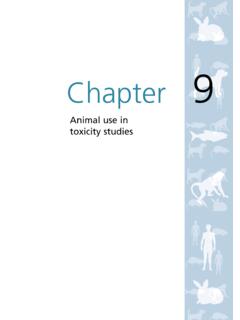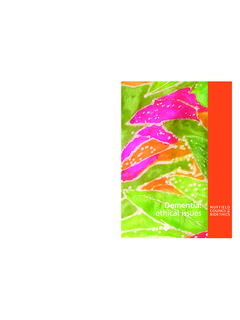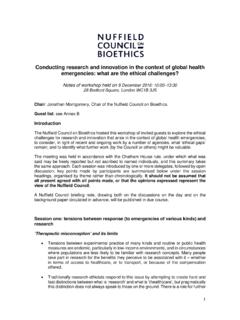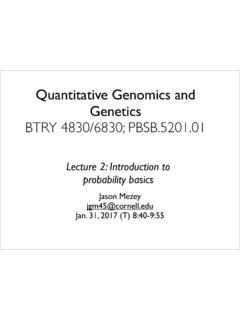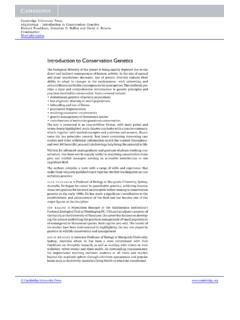Transcription of Chapter
1 quantitative genetics:measuring heritabilityChapter4 Genetics and human behaviour: the ethical context39 Chapter 4 quantitative GENETICS: MEASURING HERITABILITYQ uantitative genetics: The field of quantitative genetics originated around 1920, following statisticaldemonstrations that traits which are normally distributed can arise from the action ofmultiple genes, each with relatively small effects (either increasing or decreasing the valueof the trait).1 Various complex statistical techniques are employed in such research. In thischapter, we explain the concept of heritability, but do not provide a detailed account of thestatistical then go on to describe the three ways in which data about humanbehaviour are obtained in this field of research, namely twin, adoption and family studies.
2 How is population variation examined using genetic studies? Influences on the total population variation that is observed for a particular characteristiccan be subdivided into different components: genetic influences Environmental influences Gene environment correlation (see Box ) Gene environment interaction (see Box )The following paragraphs explain how these factors are accounted for,statistically, in quantitative research. genetic influences on quantitative research techniques can be used to estimate the influence of unspecifiedgenetic factors on behaviour. This is done by using a statistical concept called heritability ,which was first derived by plant breeders to help them reproduce desirable characteristicsin agricultural products such as corn and wheat.
3 It is a complicated concept that can be usedin various ways. It is frequently misinterpreted by scientists and other commentators onresearch in behavioural There is a common sense notion of heritability or inheritance that is concerned with theextent to which particular characteristics in an individual are the result of what one inherits(nature), the environment and world one grows up in (nurture) or some combination ofthese two (see paragraph ). Most developmental psychologists adopt a perspective of interactionism a process of development involving both factors. In the context ofresearch in behavioural genetics, however, heritability has a more precise statisticaldefinition.
4 This defines heritability as a statistical ratio that, for a given quantitativecharacter and against a fixed environmental background, estimates the proportion of theobservational differences in that characteristic across a population that can be attributed1 See paragraphs further information in this area, see: Carey, G. (2002). Human Genetics for the Social Sciences. London: Sage Publications;Plomin, R., DeFries, J. C., McClearn, G. E. & McGuffin, P. (2000). Behavioral Genetics. 4th ed. New York: a very clear discussion of concepts of heritability, see Daniels, M., Devlin, B. & Roeder, K. Of genes and IQ. In Devlin, B. etal. (1997). Intelligence, Genes and Success. New York: and human behaviour: the ethical context40to genetic influences.
5 It is a statistic that refers solely to a group of individuals and does notconcern the process of development in the Estimates of heritability may be divided into two types, which depend on the way in whichvariation within a population is accounted for. There are four aspects of variation: additivegenetic variance, variance due to genetic interaction (epistasis), variance due to interactionbetween alleles (dominance), and variance due to environmental causes. Narrow-senseheritability is defined as the proportion of variance that can be attributed to transmissiblegenetic factors. Narrow-sense heritability measures the part of variance attributable in apopulation to the additive effect of genes, independently of interaction effects betweenalleles, between loci and between the genetic make-up and the environment.
6 This providesa statistical estimate to answer the question that an animal or plant breeder will ask: ifselective breeding is applied for a particular characteristic, will it work? There is a different concept of heritability, which is also used in research in behaviouralgenetics that examines human populations, known as broad-sense heritability. This dealswith the total variance due to genetic differences, whatever their origin (additive orinteractive). Heritability in the broad-sense does not yield a figure that is predictive andtherefore helpful to a breeder of plants or animals. Nor, of course, does it answer thecommon sense question about the extent to which genetic factors and environmentalfactors influence the development of characteristics in an individual.
7 The estimate ofheritability most commonly used in research studies is narrow-sense heritability, whichaccounts only for additive genetic variance. (All figures for heritability quoted in thisReport are narrow-sense values, unless stated otherwise). It is vital to understand that neither concept of heritability allows us to concludeanything about the role of heredity in the development of a characteristic in anindividual. Heritability refers to the proportion of variation in the populationattributable to genetic influences. Thus, for example, an estimate of heritability of notmean that 60% of a particular person s trait is explained by their genes. Whatit does mean, is that in a given population that varies for a particular trait, 60% of thatvariation across the whole populationis the result of differences in their genotypes.
8 Asheritability is a proportion of the total variance, the estimate will vary depending on thevariation in the population of genetic and environmental factors. For example, if there isa population of individuals who are genetically identical for all relevant genescontributing to a given trait (that is, they all carry the same alleles for those genes; clearlya hypothetical situation), the narrow-sense heritability for the phenotypic characteristicrelated to those genes would be zero, because any differences must, by definition, beattributed to environmental It is important to distinguish heritability from genetic determination. Novel environmentalchanges might have dramatic consequences on a phenotype. A standard example is heritability of height in most populations is probably over , that is to say, 90% ofvariation in height in most human populations can be attributed to genetic the4 See for example, Phillips, K.
9 & Matheny, A. P., Jr. (1990). quantitative genetic analysis of longitudinal trends in height:preliminary results from the Louisville Twin Study. Acta Genet. Med. Gemellol. (Roma) 39: 1,143 63; Carmichael, C. M. &McGue, M. (1995). A cross-sectional examination of height, weight, and body mass index in adult twins. J. Gerontol. A Med. Sci. 50, 237 44; Preece, M. A. (1996). The genetic contribution to stature. Horm. Suppl 2, 56 8; Silventoinen,K., Kaprio, J., Lahelma, E. & Koskenvuo, M. (2000). Relative effect of genetic and environmental factors on body height:differences across birth cohorts among Finnish men and women. Am. J. Public Health 90, 627 and human behaviour: the ethical context41 Chapter 4 quantitative GENETICS: MEASURING HERITABILITY average height of most Western populations increased by cm per decade between 1920and 1970, even though the genes in those populations could not have changed large outbred populations, any noticeable change in the frequency of particular geneswill take many centuries.
10 The example is apposite, because a similar increase in IQ test scoresalso occurred throughout most of the twentieth century in most industrialised countries. Atdifferent times and places, this increase ranged from to 10 IQ points per high the heritability of IQ might be, and it is certainly not as high as ,environmental changes can potentially have a substantial is worth noting that anysociety that succeeds in reducing differences in the environments experienced by differentmembers of that society, for example, by improving education services in deprived areas, willprobably increase the heritability of their characteristics in this case, influences on Environmental variance includes a proportion of variance that can be explained by sharedor common environmental influences and a remaining proportion accounted for by non-shared environmental factors, random effects and error.
